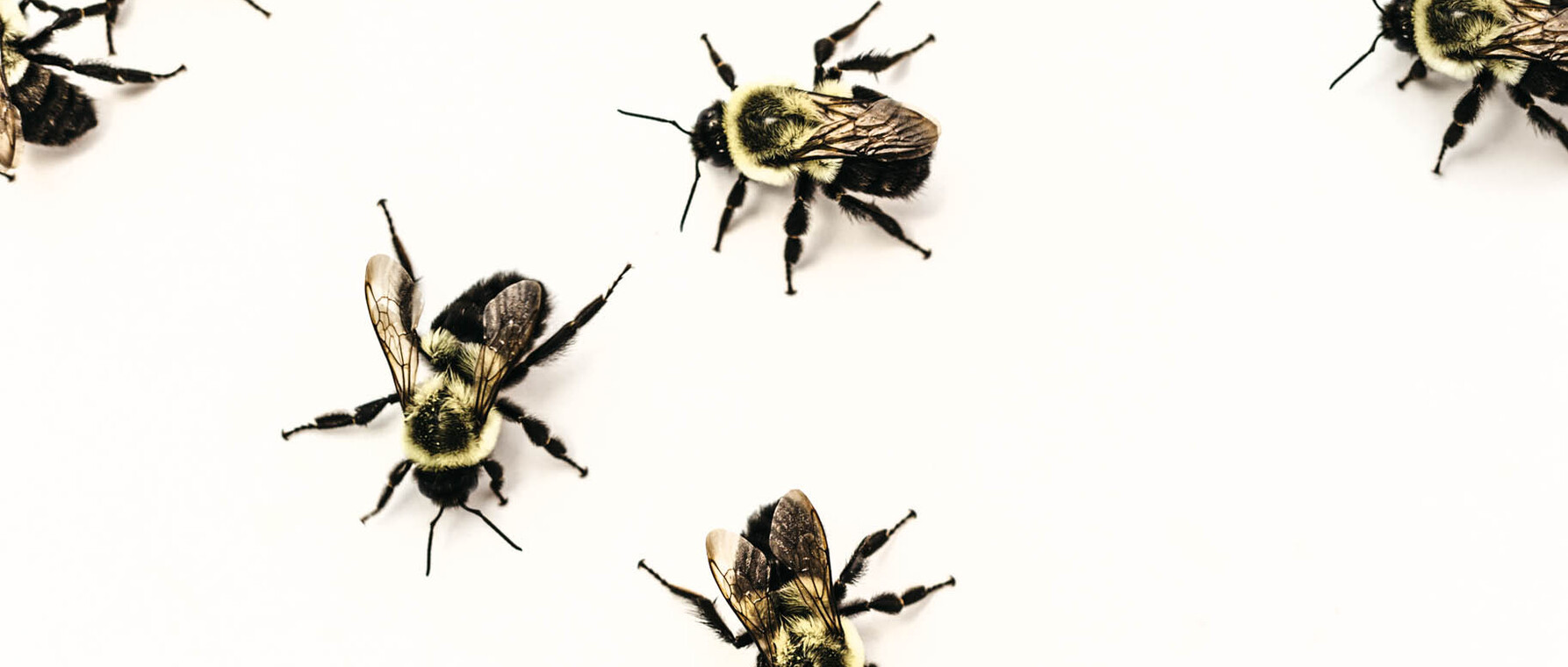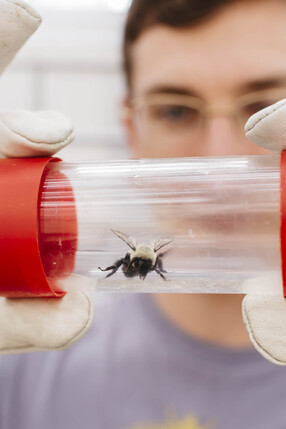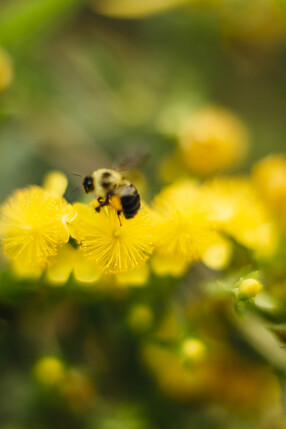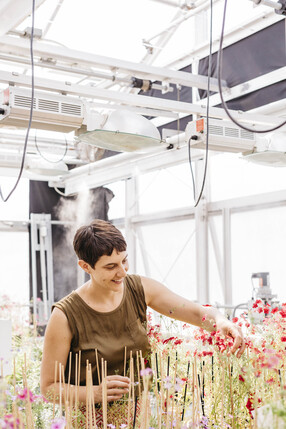What’s the Buzz? Bees, Behavior, and Pollination
One graduate student’s investigation of bumblebee behavior.

If you were one of the 250,000 people who visited Harvard’s Arnold Arboretum in 2013, you might have witnessed a curious spectacle that summer when a dizzying array of flowers was in bloom.
And you might have seen a tallish young man wearing headphones, with an insect net propped beneath his elbow, holding a microphone up to flowers and waiting patiently. The individual in question, a GSAS PhD student in organismic and evolutionary biology named Callin Switzer, was not trying to substantiate rumors that flowers can actually sing. Instead, he was capturing the sounds of bumblebees in an attempt to determine the frequency at which they flapped their wings and otherwise shook their bodies. The exercise garnered “a lot of weird looks,” Switzer recalls—not from the bees, which did their best to ignore him, but from human passersby, who couldn’t figure out what this apparent eccentric was up to.

For Switzer, these early measurements laid the foundation for his subsequent PhD work, which he expects to wrap up in spring 2017. His research is centered on “buzz pollination”—an unusual method by which bumblebees and other select bee species liberate pollen from a flower’s male anther in order to amass food for their respective colonies. Bumblebees accomplish this by grabbing the anthers with their bodies and mandibles (or jaws) and then creating a “buzz”—vibrating themselves at the right frequency until the pollen comes free. While the bees gather pollen in this way, some of those precious grains may inadvertently be delivered to the female stigma of another flower, allowing the plant to reproduce by making seeds.
Switzer, for one, finds the bee’s tactic fascinating, both from a biomechanical point of view and from the standpoint of adaptation and evolution. It doesn’t take long to sense an obsessive quality to his labors. During an interview with this magazine in June, Switzer spoke nonstop about bees for several hours straight with no ostensible waning in enthusiasm. He wore a T-shirt that said “The Bee Course,” referring to a nine-day workshop he attended in Arizona. He’s even taken up leather craft as a hobby, currently making a belt that has six different bees and flowers carved into the sides.
An Increasing Preoccupation
But Switzer wasn’t always so entranced with members of the Apidae family. As a kid growing up in Bozeman, Montana, he didn’t give much thought to bees, which can be found throughout his home state and, indeed, on every continent save for Antarctica. Nor did he plan on studying bees when he came to Harvard in 2012 (after graduating from Gonzaga University in 2010 and spending two years teaching middle school science in Gallup, New Mexico—“the hardest thing I ever did,” he claims). He assumed that he’d be investigating dragonflies, which was what his first graduate advisor, Stacey Combes, concentrated on.
Then he got sidetracked. One of Combes’ graduate students, James Crall, was using radio-frequency identification (RFID) tags to monitor the behavior of bees. Switzer spent time with Crall during his research outings and found himself becoming increasingly preoccupied with bees. He was particularly struck by their role in pollination, which contributes to the production of about a third of the foods that humans eat.
The size and strength of bumblebees, combined with their peculiar anatomical features, enables them to buzz pollinate, which is something that more common honeybees cannot do.
Of the roughly 20,000 bee species, Switzer was most captivated by bumblebees (of the genus Bombus), which look different from more common honeybees, being chubbier and fuzzier, and also move differently through the air. According to an oft-told tale, he says, “engineers had worked out the math and proved that bumblebees ought not to be able to fly based on what we know about aerodynamics.” Those calculations evidently went astray somewhere, as bumblebees are strong, if ungainly, aviators, propelled by contractions of their mesosoma (located in the midsection and often referred to as the thorax) that cause their wings to flap about 190 times a second—flapping more than 50 times, Switzer estimates, in the time it normally takes a human to blink just once.
“Bumblebees are extremely muscular animals,” he says. “In fact, their entire midsection is almost full of muscle.” The size and strength of bumblebees, combined with their peculiar anatomical features, enables them to buzz pollinate, which is something that more common honeybees cannot do.
Buzzing Along
After a bumblebee has tucked its wings into the resting position, contractions of its flight muscles cause the bee’s thorax to deform in a rapid though periodic burst, giving rise to vibrations or buzzes that typically last about a second. For certain plants, like tomatoes, potatoes, blueberries, cranberries, and eggplants, this may be the only way, or the most efficient way, of releasing pollen.

Switzer was drawn to buzz pollination, partly because the subject has not received as much attention as it deserves in view of its importance to our food supply and partly because, as phenomena go, it’s pretty darn cool. His 2013 recordings at the Arboretum constituted an initial foray into this research area, but that was enough to get him hooked. After recording 350 bumblebees that summer, he calculated an average buzz pollination frequency of about 270 Hz, “equivalent to a C-sharp above middle C on the piano.” On humid days, early in the summer, bumblebees tend to buzz at even higher frequencies, he discovered. And an individual bee could increase its buzzing frequency by at least 90 Hz.
He followed up on this fieldwork by reading as many journal articles and books as he could find on the subject. He also continued with his recordings, both audio and video, trying to measure, for instance, the frequency of vibrations for a single, non-foraging bumblebee detained briefly inside a jar.
Head Banging Bees
As the experiments proceeded, Switzer correctly surmised that he’d soon be accumulating reams of data—hundreds and hundreds of gigabytes—that would require meticulous handling. So he completed a master’s program in statistics during the 2014–2015 academic year. That didn’t leave much time for research, but he took full advantage of his winter break, spending a month in Australia.

Sridhar Ravi, a former Combes postdoc currently based at RMIT University in Melbourne, had contacted Switzer, encouraging him to study Australia’s native, blue-banded bees to figure out how they pollinated tomatoes. With support from a Putnam Expedition Grant, Switzer spent part of December and January watching these bees in action at the Botanic Gardens in Adelaide, about 400 miles northwest of Melbourne.
It was painstaking work. On one occasion, Switzer had to wait almost five hours to obtain a video of a bee lasting only a second. But it was worth the wait because what he and his colleagues found was truly astounding. It had been assumed that blue-banded bees, like bumblebees, unleashed pollen from a plant by latching onto the anthers with their mandibles and shaking. High-speed videos told a different story: the Australian bees dislodged the pollen by banging the flowers with their heads, 350 times a second. The rapid-fire head butts created an audible buzz—a higher pitched one than bumblebees generally produce.
New Avenues
After Combes, a coauthor of the “Shakers and head bangers” paper, left Harvard for the University of California, Davis in 2015, Switzer decided to continue his research with evolutionary biologist Robin Hopkins, an assistant professor of organismic and evolutionary biology, whose lab is based in the Weld Hill Research Building on the edge of the Arboretum. It’s been an agreeable set up, allowing him to make use of Weld Hill’s state-of-the-art microscopy equipment, greenhouses, and environmentally-controlled growth chambers. He also has access to the Arboretum’s world-renowned collection of more that 15,000 curated plants, while working just a few steps away from the great outdoors—a stunning, 280-acre expanse of hills, trees, flowers, birds, and, of course, bees.
We’re starting to think more about pollinator learning and how that learning can make pollinators more efficient at what they do.
Switzer has proven to be a good complement to Hopkins’ team. “There is a general theme in our lab of studying plant-pollinator coevolution,” Hopkins says. “Although this subject dates back to Darwin, there are many things we assume but less we know.” Switzer’s work, she adds, “has opened up new research avenues in the lab. We’re starting to think more about pollinator learning and how that learning can make pollinators more efficient at what they do.”
Hopkins calls Switzer “an incredibly creative and hard working student,” and 2015 turned out to be a productive year for him. He made further recordings at the Arboretum, demonstrating that bumblebees “sonicate,” or buzz, at different frequencies while visiting different plants—Chinese beautyberries, roses, and St. John’s wort—perhaps as a means of maximizing their pollen take. His lab experiments, in which he placed bees in cages with different plants, yielded similar results.
In that same year, Switzer tested different methods of marking bees, either by attaching numbered tags between their wing bases or by painting patches of their bodies. He found that bees marked with paint were much more likely to collect pollen than those that were tagged. “The only drawback,” he notes, “is that paint can chip off. And if you’re marking more than 100 bees, you quickly run out of colors.”
Keeping Focused
In research performed in 2015 and published a year later, Switzer and Combes assessed the effects of the common neonicotinoid pesticide, imidacloprid, on bumblebees. Consuming 0.05 nanograms of the toxin had no discernible effect on behavior. Bumblebees that ingested 0.5 nanograms of imidacloprid, however, were less likely to pollinate than unexposed bees, and animals that consumed 5 nanograms, so far as the researchers could tell, never pollinated again.

In April 2016, the Maryland legislature approved a bill that would prohibit consumer uses of neonicotinoids (pending the governor’s signature), and Switzer believes a broader ban could help protect declining bee populations nationwide. But he’s reluctant to get involved in a political controversy while trying to wrap up his dissertation. He’s keeping his focus, instead, squarely on science, though sometimes that can lead in unexpected directions.
In spring 2016, for example, Switzer was on the grounds with Arboretum director William (Ned) Friedman, who told him about mountain laurels (Kalmia latifolia), which were just coming into bloom at the base of Hemlock Hill. These flowers have a novel way of dispersing pollen: Their anthers are cocked back like a spring, and when a bee lands on the petals, the spring is released and pollen is catapulted into the air. Given that Kalmia latifolia only blooms for a few weeks, Switzer dropped what he was doing to study the phenomenon with Hopkins and others—both in the wild and in the lab—trying to determine whether this is an effective mechanism for getting pollen onto a pollinator. “No one knows how the interactions between plants and animals work in the case of mountain laurels, and it will be really exciting to find out,” says Friedman, the Arnold Professor of Organismic and Evolutionary Biology.
“A lot of projects around here start this way, serendipitously, because you are literally immersed in plants,” Friedman adds. “There’s a stimulus that comes from being so close to the organisms you study.” The proximity to nature helps motivate and energize the 70 or so research scientists and students that work at the Arboretum’s Weld Hill Research Building, Friedman asserts, contributing to an incredibly vibrant and interactive community.
Switzer realizes he is well situated to pursue his interest in bees. The animals have been good to him, a source of countless hours of enchantment. And he’s only been stung once for his efforts, despite the almost constant exposure, and that incident was not even the bee’s fault. Switzer was running his fingers through his hair when he came across the hapless creature, which presumably struck out in fear rather than in malice. Although Switzer finds the work engrossing, and sometimes even thrilling, there can be frustrating moments, he admits, “as it’s hard to get bees to do what you want them to do when you want them to do it.” The same, of course, can be said about humans. But Switzer goes further when it comes to his furry Bombus friends: “The more I learn about bees, the more interesting they become.” And it’s hard to say that about every person you meet.
Photos by Michael Piazza, Illustration by Patrick Hruby
Get the Latest Updates
Join Our Newsletter
Subscribe to Colloquy Podcast
Simplecast




